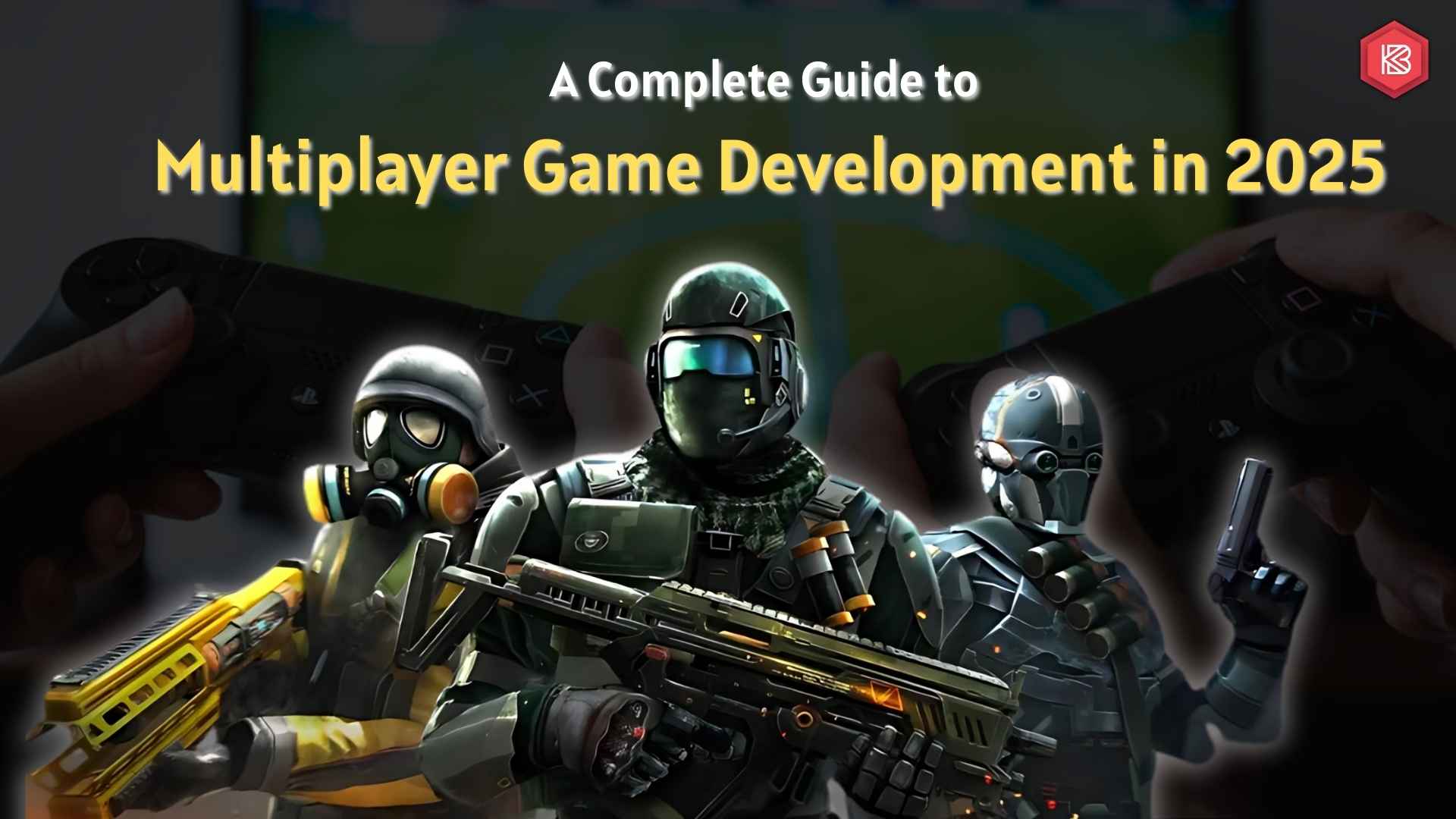A Complete Guide to Multiplayer Game Development in 2025

Multiplayer games have turned the gaming experience into something dynamic, social, and highly involved. These days, single-player games are no longer the only option, players from all over the world can interact, compete, and work together in real time. This increase in popularity is more than just a trend, it is the result of developing technologies, attractive gameplay mechanics, and a growing demand for social connection in digital spaces. Multiplayer games provide engaging experiences that appeal to a diverse player base, ranging from cooperative objectives to competitive showdowns. We examine the factors that contribute to their appeal, the technology behind them, the development process, and the prospects for this dynamic genre in this blog.
What are Multiplayer Game?
As the name suggests, multiplayer is a game that allows multiple players to interact and play with each other in a normal game world. Interaction can take many forms, including online social experiences, competitive forums, and cooperative games.
What is the Reason for Their Popularity?
This game has gained popularity in recent years as it offers players many advantages, such as the following.
The challenge of competition: Unlike other games, multiplayer games offer players an exciting and competitive gaming experience against other players, testing their strategies and skills
Interpersonal communication: In multiplayer games, players can hang out and interact with fellow players and friends, creating a sense of community.
Diverse Variety: There are games that many people play. This means there is always something different for everyone, from professionals to shooters.
Significant Technologies and Tools
Here are some of the major technologies and tools used in multiplayer games.
- Game Engine: Multiplayer game developers use game engines like Unreal Engine and Unity because they provide the foundation and resources to build multiplayer games.
- Programming languages: JavaScript, C++, and C# are popular programming languages for multiplayer games. The language you choose depends on your team’s skills and the game mechanics you’ve selected.
- Network Interface: Network middleware solutions, such as Photon and Mirror, help facilitate the use of multiplayer content.
- Server Hosting Services: You need to partner with a server hosting provider to host your multiplayer game. Server hosting providers like Microsoft Azure and Amazon Web Services (AWS) are reliable and ensure stable online gaming.
Multiplayer Game Server: 2 Vital Types
To start the procedure of developing multiplayer games, it’s critical to understand the basics of what a multiplayer server is. Here are the two most commonplace approaches to applying multiplayer sports servers in the real world.
Local Player-Hosted Game Server
The local player-hosted game server is a common way to implement multiplayer in games in the gaming industry (e.g., Minecraft). Specifically, it allows any particular player to create a multiplayer game (with the ability of other players to participate) on their local machine. In practice, a game developer allows their game to automatically start a server on the player’s machine (which hosts multiplayer games) and direct players to other players who are connected and playing on the server, so that any player anywhere in the world can get it. in a multiplayer fantasy game that their friends can join.
Dedicated/Cloud Game Servers
The dedicated/cloud game server approach is also prevalent in the industry and is used quite regularly for competitive-based games (such as Apex Legends and Call of Duty). The key to this approach is providing the game server to somewhere on a remote server in the cloud. For example, a game server can be deployed to a cloud platform such as Red Hat OpenShift, and players can join generated game sessions hosted in that cloud. This approach takes the burden off the resident player to host, essentially; the manager directs the game.
Development Process of Multiplayer Game
There are several key components to building a multiplayer game, from pre-development to post-release support. Here is an overview of the event:
Ideology and Planning
The journey begins with a sense of play. What game will you play? Explain the game’s genre, gameplay mechanics, and methods of interaction. A well-thought-out design document is your road map.
Before the Production
During the pre-production phase, you’ll assemble your development team, conduct market research, and develop a detailed work plan. This phase is critical for setting goals, timelines, and budgets.
Sample materials
Create a prototype or minimum feasible product (MVP) to check the core multiplayer mechanics of your game. Prototyping facilitates the discovery of ability problems early on and allows for flexibility before complete development starts.
Development
The heart of game development is the building phase. This is where your team works on coding, artwork, audio, and level design. Constant playtesting and iteration are essential to refining the multiplayer experience. You can also look for Unity Game Development Services to create your dream game.
Network Infrastructure
Create a community configuration in your multiplayer recreation by considering server-client communication, information synchronization, and anti-fraud measures.
Quality Assurance (QA)
Testing is important to ensure your multiplayer is perfect and balanced, and provides a smooth online experience.
Customization
In multiplayer video games, optimization is important for smooth gameplay and reducing latency issues. This includes the optimization of code, assets, and community functions.
Marketing and Promotions
Start trading your multiplayer game before its release. Build a website, create a social media presence, and connect with potential players to keep you interested.
Server Hosting Installation
Choose a reliable server hosting solution to support your multiplayer game online infrastructure. Consider using dedicated game server providers or cloud-based solutions.
Presentation of Measurements
Launch day is an exciting and nerve-wracking time. Be sure your multiplayer game is ready for release, handle marketing efforts, and check player feedback and reviews.
Post-release Support
Game development doesn’t end with launch. You need to provide ongoing support, including up-to-date support, patches, and solving player problems.
Evolution of Multiplayer Gaming
Let’s dive into the exciting world of multiplayer gaming, explore how it’s evolved, and lay out how we participate and compete in the virtual world.
Initial Stage: Local Multiplayer
Remember when multiplayer meant gathering around a screen with your friends? Local multiplayer moments with split-screen features and split controls created unforgettable gaming moments. Titles like Mario Kart and GoldenEye 007 set the stage for what was to come and created a sense of camaraderie in living rooms.
The Rise of Online Multiplayer Gaming
Fast forward to the internet age, and the landscape of multiplayer gaming experiences has changed dramatically. Multiplayer online gaming has emerged, allowing players to interact with friends or enemies. Games like World of Warcraft and Halo 2 paved the way for massive online communities where players could collaborate, compete, and make friends beyond geographical boundaries.
The Social Media Integration
With the rise of social media, mass experiences have transcended game systems. Communication combined with platforms like Facebook and Twitter allowed gamers to share their achievements, challenges, and gaming experiences with a wider audience. The line between gaming and social interaction blurred, creating a global gaming culture that extended beyond the confines of consoles and PCs.
Cross-Platform Gaming Emerged
In recent years, the idea of position-playing video games has gained momentum. Games like Fortnite and Rocket League broke down the limitations between distinct gaming ecosystems, permitting players on diverse systems to group up or meet each other Cross-platform games not only provide accessibility it no longer only going up but also encourage inclusion inside the gaming network.
The Era of Cloud Gaming
As we step into cloud gaming, the design of multiplayer experiences is undergoing a paradigm shift. Services like Google Stadia, Xbox Cloud Gaming, and NVIDIA GeForce Now pave the way for simple gaming on devices, eliminating the need for high-end hardware. These advances make gaming not only accessible but also deliverable, another possibility for cooperative as well as competitive experiences.
Multiple Collaboration: Beyond Competition
While competition has always been the driving force behind multiplayer gaming, offering cooperative multiplayer experiences opens up new possibilities. Games like Among Us and Phasmophobia emphasize teamwork, verbal exchange, and trouble-fixing, fostering a united spirit that goes beyond the conventional model of player versus participant.
The Advent of Virtual Reality (VR)
Virtual reality is revolutionizing multiplayer experiences. Games like Beat Saber and Rec Room are changing how we interact with virtual environments and each other. VR immerses players in new games and enhances the social aspect, making it feel like you’re sharing a space with other players.
The Metaverse: The Future Frontier
As we gaze into destiny, the metaverse concept takes the middle stage. The Metaverse represents a virtual shared space that combines augmented reality, virtual reality, and the Internet. In this interconnected universe, multiplayer stories reach unprecedented levels, transcending the boundaries of gaming to include social interaction, commerce, and the past.
Challenges in Multiplayer Game Development
While the popularity of mass gaming is undeniable, it is important to understand the challenges associated with making these games. Here are some of the major obstacles game developers face.
Synchronization and Latency
In Multiplayer games, all players must be aware of and interact with the game world. To achieve synchronization across devices and networks when latency (the delay between an action and its effect) is a complex task, Developers need to find solutions that provide players with a seamless and accurate gaming environment.
Scalability of Performance
Multiplayer games can range from small video games to big online worlds in which thousands of human beings play at the same time. It is tough to create a system that could scale to deal with this wide variety of gamers while retaining consistency. Server infrastructure and net code are designed to handle these players.
Deception and Security
Cheating can severely disrupt the multiplayer experience. Manufacturers need to implement strong security measures to prevent fraud and ensure consistency. This includes finding and preventing hacks, cheats, and exploits.
Data Transfer and Bandwidth
Multiplayer games require a constant exchange of information between the players and the game controller. This data transfer depends on the bandwidth of the network. It is important to optimize this process to minimize bandwidth consumption and keep the game running smoothly.
Balanced Games
Balancing multiplayer games is a complex process. Developers need to make sure that no one player or style dominates. Finding that balance by offering different characters, abilities, or gameplay is a tough challenge.
Conclusion: Future of Multiplayer Gaming
As technology advances, the destiny of multiplayer gaming looks promising. The manner in, we play together is being revolutionized, through rising technology, inclusive of 5G, cloud gaming, and augmented digital reality. These new functions will carry new challenges, in addition, they open the door to interesting possibilities.
Multiplayer gaming has advanced significantly, from co-op to enormous online universes that connect gamers from all over the world. The multiplayer experience is upgrading due to developments like cloud gaming, virtual reality, cross-platform play, and the rising metaverse. Even if issues like latency, scalability, and security still exist, there is a ton of opportunity for increased accessibility and deeper immersion in the future.
As developers want to push the boundaries and satisfy the changing expectations of gamers, collaborating with the proper development team becomes important. Kryptobees, a leading game development company that specializes in developing modular, intriguing, and high-performance multiplayer games, assists innovators in realizing their ideas for games, bringing players together, and generating lifelong memories of shared experiences in the virtual world.
 Discuss Project!
Discuss Project!